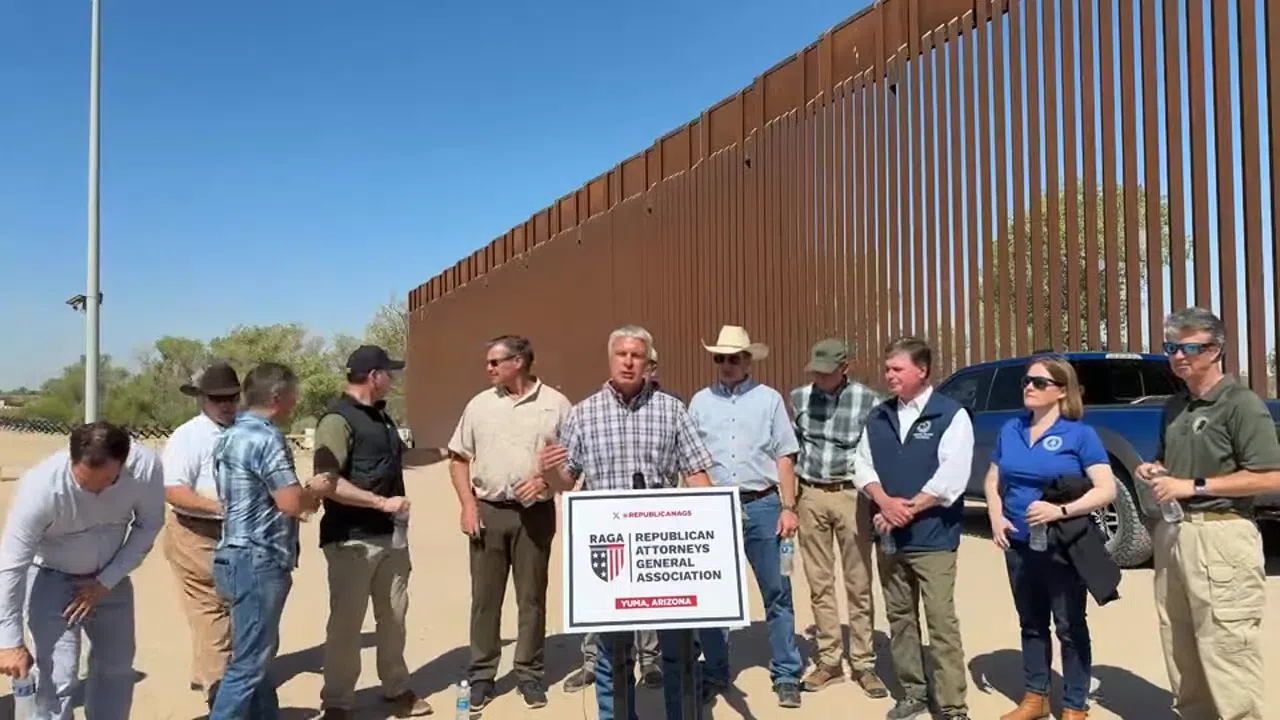

Trump’s Border Policies and Their Impact on Public Health
In today’s politically charged environment, the policies implemented at the southern border have stirred passionate debates about their unintended consequences on public health. With controversial decisions regarding border security and reduced funding for essential health programs, it’s worth taking a closer look at how these measures are intertwined with the rising crisis of overdose deaths, especially those resulting from fentanyl. This editorial aims to dig into the tangled issues at the intersection of border policy and health, revealing how supply-side tactics have neglected the demand for addiction treatment and harm reduction efforts.
Understanding the Link Between Border Security and Overdose Epidemics
When strict border enforcement becomes the focus, we often see an overemphasis on punitive measures. Recent initiatives such as building more walls, deploying military personnel, and intensifying immigration arrests are designed to curb illegal entry. However, these measures—while politically appealing to some—have real-life ramifications for communities already grappling with the overdose epidemic. They serve as a distraction from addressing the key demand drivers behind drug addiction and overdose deaths.
Fentanyl’s Rise and Its Connection to Border Policies
The synthetic opioid fentanyl has emerged as a major player in the overdose crisis. Its widespread availability is not solely a result of failing drug interdiction efforts at the border but also a consequence of market demand that persists regardless of supply-side interdiction. When border measures become increasingly militarized and politically charged, the focus shifts away from the more complicated pieces of addiction treatment and harm reduction that could actually save lives.
Fentanyl is manufactured with surprising ease—often in hidden domestic setups or remote laboratories. Its production does not rely on the traditional routes associated with heroin cultivation in specific regions. Given this reality, efforts solely aimed at reducing supply at the border tend to be like trying to plug a leaky bucket without addressing the source of the leak. The result is that, even as the government builds new physical barriers and deploys more personnel, the demand for the drug remains high, and fatal overdoses continue to impact thousands of lives.
Supply-Side Tactics vs. Demand-Reduction Measures
A closer look reveals that current policies lean more toward arresting individuals or targeting drug suppliers, rather than reducing the underlying demand. There is a significant difference between limiting the access to illicit drugs by focusing on their supply and mitigating overdose deaths by enhancing addiction treatment and harm reduction measures. The latter involves a focus on proven interventions such as naloxone distribution, overdose prevention centers, and expanded access to medications approved for treating opioid use disorder like methadone, buprenorphine, and naltrexone.
Strategies that concentrate solely on restricting drugs at the border are inherently limited because:
- The production of synthetic opioids can shift quickly to different regions.
- The nature of the drug market means that demand will often adapt to new products once old ones are restricted.
- These tactics overlook the super important need for treatment programs that address opioid use disorder.
The Ramifications of Funding Cuts on Health Programs
Another concerning development is the proposed or actual slashing of funding for crucial public health initiatives. Over the past few years, significant budget cuts have affected agencies like Health and Human Services, the Substance Abuse and Mental Health Services Administration, and the Centers for Disease Control and Prevention. Moreover, some programs that are essential for overdose prevention, such as Medicaid-funded treatment and naloxone distribution programs, are now at risk.
Losing Access to Life-Saving Medications and Treatment
The reduction in funding can be directly linked to lower access to life-saving tools like naloxone, a medication that rapidly reverses opioid overdoses. It is often the difference between life and death in desperate times. In addition, programs that support addiction treatment through evidence-based medications help patients stay alive and recover, reducing transmission rates for diseases like hepatitis C and HIV.
With fewer resources, communities find themselves facing a number of off-putting challenges, including:
- Reduced availability of medications for opioid use disorder.
- Shuttering or downsizing of overdose prevention centers that offer immediate help during emergencies.
- A diminished capacity for local hospitals and clinics to manage the overwhelming demand for addiction treatment services.
Impact on Rural Communities and Borderlands
In rural regions, particularly those along the border, the situation is even more precarious. Many residents depend on government-funded programs to access basic healthcare services. With nearly one in four residents relying on Medicaid, any significant funding cuts could leave a vast number of people without critical support. In these areas, the challenges become even more nerve-racking as both healthcare access and economic stability face additional pressures.
Local organizations, like harm reduction centers and community health clinics, often operate on extremely tight budgets. These organizations are the lifeline for individuals struggling with addiction, and without proper federal support, they struggle to maintain operations. The consequences of these cuts extend beyond individual health and affect the community as a whole, leading to higher rates of overdose deaths and a weakened public health infrastructure.
Historical Lessons on Drug Policy and Marginalized Communities
Examining the history of drug legislation in the United States reveals a pattern where policies have not only failed to reduce drug use but have also often targeted minoritized communities. Whether it was during the opium scares of the 1870s, the vilification of cannabis in the 1930s, or the racial disparities of the 1980s crack epidemic, the strategy has consistently been to shift attention away from demand reduction measures and toward punitive supply-side approaches.
Lessons from Past Policies and Their Unintended Consequences
Historical examples offer valuable insights into why it is essential to change our approach:
- Opium and the Chinese Immigrants: In the 19th century, fears were stoked around the use of opium by Chinese immigrants. This scare led to the criminalization of opium without addressing the underlying social and economic issues that led to its use, ultimately creating a legacy of stigmatization.
- The “Reefer Madness” Era: In the early 20th century, officials began using the term “marijuana” to associate the drug with Mexican immigrants. This shift in language and focus contributed to severe criminal penalties, reinforcing negative stereotypes and hindering efforts to treat cannabis use through public health measures.
- Racial Disparities in Cocaine Laws: With the Anti-Drug Abuse Act of 1986, mandatory minimum sentences for crack cocaine (associated with Black communities) were set dramatically higher than for powder cocaine. This policy led to mass incarceration and left many communities without support for those dealing with addiction, even though the pharmacological differences between the drugs are minimal.
These historical missteps underline that punitive drug policies and harsh border security measures do little to address the super important issues of addiction and public health. Instead, they tend to exacerbate problems and contribute to long-term societal harm.
The Dangerous Cycle of Punitive Measures
When governmental strategy focuses on arrest and incarceration as the primary response to drug use, it sets off a dangerous cycle. Once incarcerated, individuals with substance use disorders are more likely to experience relapse post-release due to a lack of effective treatment options in prisons and a challenging environment to resume recovery immediately upon reentry into society. This cascade of difficulties further burdens the public health system.
Decades of reliance on punitive measures have shown that trying to plug the problem through enforcement has not only been largely ineffective but has also inadvertently increased the risk of overdose. For many people living with addiction, the cycle of incarceration only deepens barriers to accessing the treatment they need.
Policy and Public Health: A Need for a Balanced Approach
While border security is undeniably an important aspect of national policy, it is clear that a heavy-handed approach focused solely on supply reduction is not enough. If we want to effectively reduce overdose deaths and improve overall public health, there is an urgent need for policies that balance security concerns with robust public health measures.
Increase in Community-Based Health Initiatives
One promising avenue is the expansion of community-based programs that focus on harm reduction and addiction treatment. These initiatives incorporate both medical and social support to help individuals steer through their addiction challenges. Examples include:
- Overdose Prevention Centers: Facilities where people can use drugs under medical supervision, which have been shown to significantly reduce the risk of fatal overdoses.
- Naloxone Distribution Programs: Increasing access to this life-saving drug can prevent countless deaths by rapidly reversing opioid overdoses.
- Addiction Medicine Fellowship Programs: Training more medical professionals in addiction treatment ensures a steady stream of healthcare providers who are skilled in managing opioid use disorders.
- Peer Support Networks: Community groups that provide emotional and practical support, helping individuals navigate the challenging journey to recovery.
These programs not only help reduce the immediate risks associated with overdose but also pave the way for long-term recovery and societal reintegration. Investing in such initiatives is a super important step toward lowering overall addiction rates and minimizing the broader impacts on the community.
Reallocating Resources to Health Programs
A major point of contention is the threat to funding for these critical health programs. Redirecting resources away from public health in favor of more aggressive border enforcement may appear attractive in political rhetoric, but it is a self-defeating strategy in practice. Effective public health measures require steady investment. This means ensuring that funding for agencies like the Centers for Disease Control and Prevention, the Substance Abuse and Mental Health Services Administration, and local health departments remains robust, even in the face of other political priorities.
Ensuring that local communities, particularly those on the border, have sufficient funding to tackle these issues is a key component of an effective response. Without such resources, the existing programs that have proven successful in reducing overdose deaths are at risk of shuttering, leaving many individuals without the support they desperately need.
Economic and Social Costs of Prioritizing Enforcement Over Health
Beyond the immediate health implications, there are significant economic and social costs associated with a policy environment that prioritizes strict enforcement over comprehensive harm reduction and treatment. When funding is diverted away from public health efforts, the broader community bears the burden.
Escalating Costs to the Healthcare System
The addiction crisis not only affects individuals but also places an enormous strain on the healthcare system and local economies. Emergency departments and hospitals spend billions of dollars each year addressing complications related to drug use, which could be mitigated through preventative measures and early intervention. As more resources are funneled into border security and less into treatment programs, these costs are likely to grow.
Moreover, the human cost in terms of lost productivity, increased illness, and death cannot be ignored. A community burdened by untreated addiction struggles to thrive economically, and its workforce becomes burdened by the long-term effects of widespread substance misuse. In this view, the funding cuts are not just a setback for public health—they represent an investment in further economic instability.
Social Implications for Vulnerable Populations
The negative social effects of these policies disproportionately impact vulnerable populations. Immigrants and ethnic minorities, who have historically been targeted by punitive drug policies, find themselves bearing the brunt of cuts to critical health services. With a significant percentage of the population in border regions relying on government-funded healthcare, any reduction in funding can create a ripple effect, deepening existing disparities.
There is a risk that policies which are perceived as targeting immigrant communities will further alienate these groups, leading to deep-rooted mistrust of authorities. That mistrust can interfere with public health outreach and hinder efforts to implement effective treatment and prevention programs. When individuals fear that seeking help might result in legal repercussions or deportation, they are less likely to access vital services.
To safeguard the well-being of these communities, it is essential to foster trust through measures that prioritize health over policing. This calls for clear, empathetic communication from government officials and a restructuring of policies to emphasize support and rehabilitation rather than punishment.
Addressing the Tricky Parts: Policy Recommendations for a Safer Future
Given the evidence, it is increasingly clear that existing border policies and the associated funding decisions are not serving the public’s best interests. Instead, they threaten to undermine years of progress made in addressing the opioid crisis. To turn the tide, policy makers need to take a balanced approach that integrates both security concerns and health priorities.
Enhancing Harm Reduction Measures and Expanding Treatment Options
Policy makers should focus on initiatives that effectively reduce drug-related harm. This means taking concrete steps to bolster community-based programs that prevent overdose deaths. Key recommendations include:
- Reinstating and Increasing Funding: Protect and even boost funding for federal health agencies and local programs that focus on addiction treatment and overdose prevention.
- Expanding Naloxone Access: Ensure that naloxone is readily available to emergency responders, community organizations, and even the general public.
- Promoting Overdose Prevention Centers: Support evidence-based models of supervised consumption services that can immediately address overdoses when they occur.
- Boosting Addiction Medicine Training: Enhance specialized training programs to prepare more healthcare professionals to manage addiction effectively.
These measures would represent a shift away from punitive enforcement toward a model that recognizes addiction as a treatable health issue rather than a criminal matter.
Implementing a Balanced, Multi-Pronged Approach
A balanced strategy requires combining the enforcement of secure borders with robust public health initiatives. Some steps to achieve this balance might include:
- Intensifying Data-Driven Policies: Rely on sound data and community feedback to determine how resources are allocated, ensuring that effective programs continue without interruption.
- Fostering Cooperation Between Agencies: Encourage collaboration between border security forces and public health officials to ensure that law enforcement actions do not come at the expense of health services.
- Maintaining Focus on Human Rights: Ensure that all policies respect the human rights of individuals and do not disproportionately target minoritized communities.
- Encouraging Community Involvement: Engage local communities in the conversation about drug policy and public health, allowing them to help shape approaches that are best suited to their specific circumstances.
By taking these steps, policy makers can figure a path through the tricky parts of balancing tough border security with essential health services, ultimately creating a more humane and effective approach to drug policy.
Taking a Closer Look at the Real Costs of Inaction
Failure to pivot to a more balanced strategy may lead to further loss of life and long-term social damage. When fatal overdoses continue unabated because effective treatment and harm reduction programs are underfunded, the human cost becomes incalculable. Families are shattered, communities lose productive members, and the cycle of addiction becomes ever more entrenched.
Evaluating the Hidden Costs for Society
The financial burden of untreated addiction is immense. Apart from the direct medical expenses incurred by emergency services and hospitals, there are also indirect costs such as lost productivity, increased rates of mental illness, and the long-term social consequences of criminal justice involvement. These hidden complexities mean that reallocating funds away from public health in favor of enforcement does not save money in the long run—it actually contributes to greater economic strains.
Moreover, the overall quality of life is diminished when a significant segment of the population is left without adequate support. When lives are lost due to a failure to address the demand for drugs, these losses ripple across the entire community, affecting everything from local schools to public safety initiatives.
Long-Term Societal Impacts
The societal consequences of maintaining a strict, enforcement-driven policy are far-reaching. Communities that bear the brunt of these policies often experience increased stigmatization and marginalization. The cycle of addiction intertwined with mass incarceration creates a legacy of challenges that can persist for decades. When individuals are repeatedly cycled through the criminal justice system without access to meaningful treatment, their ability to contribute positively to society is severely compromised.
A comprehensive and balanced policy that marries enforcement with care is therefore not only key to reducing overdose deaths—it is crucial for the long-term health, stability, and prosperity of society.
Reflections on the Political Use of Drug Policy
The current administration’s rhetoric surrounding border security and drug policy has often overshadowed the underlying need for public health interventions. Promises to deport “millions of criminal aliens,” build walls, and wage war on cartels sound impressive to some, but they fail to acknowledge the real implications for communities burdened by addiction and limited access to healthcare.
Political Messaging Versus Practical Outcomes
Politicians have long exploited drug policy as a tool to rally certain segments of the electorate by simplifying the issue into good versus evil. This messaging, however, neglects the super important details of how addiction works and the most effective ways to treat it. Criminalizing drug use, rather than treating it as a health issue, creates a false dichotomy, one that pits law enforcement against public health.
The misdirection is clear: instead of addressing the little twists that result in overdose deaths, current policies promote a punitive approach that not only stigmatizes individuals struggling with addiction but also undermines the essential services they need. Such tactics may provide political cover, but at the cost of worsening public health and deepening societal divisions.
The Role of Evidence in Shaping Policy
Decades of research indicate that harm reduction and comprehensive treatment programs yield far better outcomes than unyielding crackdowns. Evidence shows that countries and regions that invest in evidence-based programs experience lower rates of overdose deaths and improved overall community health. Yet, political narratives continue to prioritize expensive border enforcement measures over these proven strategies.
By ignoring the small distinctions and fine points revealed by research, policy makers risk repeating past mistakes. The challenge is not only to get around the entrenched ideas about drug use and border security but also to embrace approaches that respect the human element inherent in drug addiction and recovery.
Charting a New Course for Future Policy
As much as the current debate over border security and drug policy is shaped by historic narratives and political spectacle, the future demands a more measured and balanced response. The reality is that the overdose crisis will persist unless there is urgent action to expand life-saving health services and reallocate resources to community-based approaches.
Reprioritizing Public Health in Policy Making
Steps toward meaningful change start with a clear reprioritization of public health over purely aggressive enforcement. Policy makers should:
- Reinvest in Health Agencies: Commit to consistent and predictable funding for agencies that focus on community health, treatment, and harm reduction. This will help stabilize programs vital for preventing overdose deaths.
- Reexamine Enforcement Tactics: Evaluate the true effectiveness of supply-side measures, and be willing to adjust strategies when evidence shows that such methods are not reducing overdose rates.
- Engage in Community Dialogue: Open channels of communication with the communities most affected by these policies to understand their needs and involve them in crafting responsive solutions.
- Invest in Research and Innovation: Support studies that explore new treatment methods, innovative harm reduction practices, and better ways to integrate enforcement with public health measures.
These recommendations offer a path forward that does not sacrifice human lives for the sake of political posturing. Implementing a balanced approach is not only critical for addressing current challenges but also for preparing for the tricky parts and unexpected twists that future drug policy debates may bring.
Building Resilient Communities Through Compassionate Policy
In rethinking the approach to border security and drug policy, it is essential to focus on fostering community resilience. When communities are empowered through access to health services, education, and compassionate care, they are better equipped to handle the myriad challenges of addiction and other public health crises.
A comprehensive policy must be built on a foundation of empathy and understanding. It should recognize that behind every statistic is a person—a parent, a neighbor, a friend—whose life could be saved through better policy, more funding, and a commitment to evidence-based care. Only by aligning policies with the real-world needs of communities can the cycle of overdose deaths be interrupted.
Conclusion: Prioritizing Life Over Political Theater
The intersection of border security policies and the ongoing overdose crisis presents a clear choice: continue on a path that emphasizes punitive measures and supply-side interventions, or pivot toward a more balanced approach that recognizes addiction as a health issue requiring comprehensive care and support.
History has taught us that reliance on harsh enforcement and reductions in health funding only leads to more tangled issues in the long run. The evidence is overwhelming that investment in harm reduction, treatment programs, and community health not only saves lives but also builds a stronger, more resilient society.
Policy makers ought to steer through these twisted paths with eye-opening clarity and a commitment to compassion. It is a super important moment where political leaders must put aside politically charged rhetoric and make choices based on evidence, empathy, and the absolute necessity to protect public health. Only then can we hope to reduce overdose deaths, restore trust in our communities, and create a future where safety, dignity, and health are at the core of our national priorities.
While border security is a legitimate concern, it should not come at the expense of lives that are already hanging in a precarious balance, especially in communities that are already loaded with issues. By rebalancing our priorities and investing in proven public health interventions, we have an opportunity to transform the current crisis into a rallying point for positive change—a testament to what can be accomplished when policy is guided by compassion and evidence rather than fear and political theatrics.
In the end, addressing the super important challenge of overdose deaths requires that we all work together to untangle the confusing bits of current policy and rebuild a framework that values life. The time to act is now, and the lives of thousands depend on the choices we make today.
Originally Post From https://www.salon.com/2025/05/22/trumps-border-wont-stop-overdoses-in-fact-it-might-make-things-worse/
Read more about this topic at
Fentanyl Awareness | DEA.gov
Fuel oil poisoning: MedlinePlus Medical Encyclopedia


